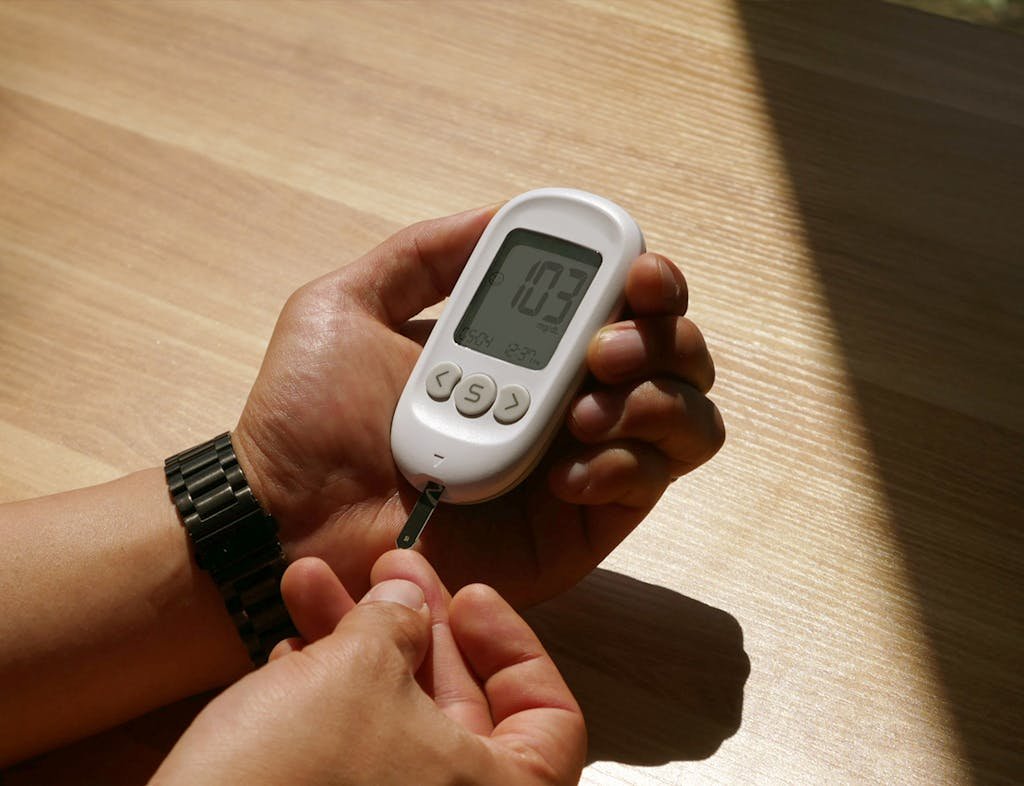Understanding Insulin Resistance in Midlife
Insulin resistance is one of the most common and most overlooked metabolic issues adults face in midlife. It can quietly impact everything from energy, mood, and weight to hormones and long-term health. The good news? Once you understand what’s happening inside your body, there are ways to reverse it.
This post breaks down what insulin resistance is, what causes it, how to know if you have it, what it affects, and the practical steps that help improve it.

Insulin is a hormone made by your pancreas that helps move glucose (sugar) out of your bloodstream and into your cells to be used as fuel.
Insulin resistance happens when your cells stop responding properly to insulin.
Your body keeps making more and more insulin to compensate, but over time this leads to:
- Higher blood sugar
- Higher insulin levels
- Fatigue and cravings
- Increased belly fat
- Hormonal imbalances
Left unchecked, insulin resistance can progress to prediabetes and eventually type 2 diabetes but it’s often reversible with the right lifestyle changes.
Many factors can contribute, but midlife adults are especially vulnerable because of:
1. Chronic Stress & Cortisol
High cortisol (your stress hormone) raises blood sugar, keeps insulin elevated, and makes your cells less sensitive to insulin.
2. Poor Sleep
Just one night of poor sleep can decrease insulin sensitivity by up to 25%. Chronic poor sleep is a major driver of metabolic dysfunction.
3. Hormonal Changes (Perimenopause / Menopause for Women, Testosterone Decline for Men)
Midlife hormonal shifts affect how the body handles glucose in both women and men:
- In women, declining estrogen and progesterone reduce insulin sensitivity and promote abdominal fat storage.
- In men, declining testosterone is linked to increased belly fat, reduced muscle mass, fatigue, and decreased insulin sensitivity, all of which raise the risk of insulin resistance.
Why this matters:
Lower testosterone in men (and lower estrogen in women) decreases muscle mass and increases visceral fat, the exact combination that worsens insulin resistance.
4. Diet High in Processed Foods & Refined Carbs
Frequent spikes in glucose overwork the pancreas and lead to insulin resistance.
5. Sedentary Lifestyle
Muscles act like sponges for glucose, when you don’t use them, they get stiff and less efficient at clearing sugar from the blood.
6. Genetics & Family History
You may be predisposed, but lifestyle still plays a major role.
Most people think insulin resistance is only about food, especially sugar or carbs but stress plays a major and often underestimated role.
Here’s what actually happens in your body:
1. Stress Triggers Cortisol and Adrenaline
When you’re stressed (physically, mentally, emotionally), your body enters a “fight-or-flight” state.
To prepare you to run or react, your adrenal glands release Cortisol and Adrenaline. These hormones tell your liver to quickly release stored glucose into your bloodstream for fast energy.
2. Blood Sugar Rises – Even If You Haven’t Eaten
This “stress glucose spike” is meant to help in an emergency. But in modern life, the stress is usually:
- Emotional
- Work-related
- Chronic
- Not resolved with physical movement
This causes glucose to rise even when you’re sitting still.
3. The Pancreas Responds by “Dumping” Insulin
Your pancreas senses the rise in blood sugar and releases a large amount of insulin to bring it back down.
This is a normal response but if it happens repeatedly throughout the day (from chronic stress), insulin stays elevated.
4. Muscles Are the Main Place Glucose Should Go — But Only if They’re Active
About 70–80% of insulin-stimulated glucose uptake happens in your skeletal muscle.
Insulin’s job is to move glucose:
- Into your muscles for energy
- Into the liver
- Into fat storage if muscles aren’t using it
But here’s the key:
If your muscles are weak, underused, or low in mass (common in midlife), they can’t absorb the glucose effectively.
When your muscle cells aren’t responding well to insulin and therefore cannot absorb and store glucose the way they’re supposed to:
- Insulin stays high
- Cells become less responsive
- Fat storage increases (especially belly fat)
- Insulin resistance begins or gets worse
5. Chronic Stress + Low Muscle Mass = Perfect Storm for Insulin Resistance
This is why midlife adults often develop insulin resistance even if they eat relatively well:
- Muscle mass naturally declines with age
- Stress increases
- Sleep gets disrupted
- Hormones fluctuate
- Movement often decreases
All of this leads to frequent stress-induced insulin spikes that the body can’t use efficiently.
Many people walk around with insulin resistance for years without knowing it because early symptoms are subtle.
- Fatigue (especially after meals)
- Cravings for sugar or carbs
- Difficulty losing weight
- Belly fat, especially “visceral fat”
- Brain fog
- Irritability if meals are delayed
- Feeling hungry soon after eating
- Darkening of skin folds (acanthosis nigricans)
Ask your provider to run the following tests:
- Fasting glucose
- Fasting insulin
- HOMA-IR score (calculated from glucose + insulin)
- A1C (3-month blood sugar average)
- Lipid panel — high triglycerides & low HDL often signal insulin resistance
Important:
You can have normal glucose and abnormal insulin. Early insulin resistance doesn’t always show up on a standard glucose test.
CGMs can show how your glucose responds to meals, stress, sleep, and lifestyle patterns. They provide real-time feedback and can be incredibly helpful, especially in midlife. These devices often require a prescription from your doctor depending on the need. If you are diabetic and don’t have one yet, ask your doctor if this would be a good option for you. If non diabetic, you can get them for health and fitness purposes through companies such as Lingo. (Non-affiliate link)
Insulin resistance doesn’t only affect blood sugar. It impacts almost every system in the body:
1. Weight & Fat Storage
High insulin signals the body to store fat, especially around the midsection.
2. Energy Levels
When glucose can’t enter cells efficiently, fatigue and crashes follow.
3. Hormones
Insulin resistance is linked to:
- Hot flashes
- PMS or cycle changes
- PCOS
- Thyroid issues
- Sleep disturbances
4. Cardiovascular Health
It increases:
- Triglycerides
- LDL particle count
- Blood pressure
- Inflammation
5. Brain Health
Higher risk for:
- Brain fog
- Mood swings
- Anxiety
- Cognitive decline / dementia
6. Gut Health
Blood sugar swings can alter digestion, cause bloating, and influence gut bacteria.
Reversing insulin resistance doesn’t happen overnight, but small, consistent changes make a big difference.
1. Balance Your Meals
Focus on:
- Protein at every meal (25-30g per meal)
- Healthy fats
- High-fiber vegetables
- Lower-glycemic carbs
Example midlife-friendly meals:
- Eggs + veggies + avocado
- Lentil soup + greens
- Stir fry veggies + tofu/eggs + quinoa
- Greek-style bowl with beans, greens, protein, and olive oil
Tip: Always pair carbs with protein or fat to reduce glucose spikes.
2. Reduce Grazing & Late-Night Eating
Spacing meals 3–4 hours apart helps insulin drop between meals.
Try to finish eating 2–3 hours before bed.
3. Move Throughout the Day
You don’t need intense workouts, you need consistency.
- A 10-minute walk after meals significantly lowers glucose
- Strength training 2–3 days a week improves insulin sensitivity
- Light movement every hour keeps glucose stable
4. Improve Sleep Quality
Aim for:
- A consistent bedtime
- Cool dark room
- Limiting screens 1 hour before bed
- Magnesium glycinate if helpful
- Stress-lowering practices before sleep
Poor sleep → higher cortisol → higher glucose.
5. Manage Stress
Chronic stress is one of the biggest drivers of insulin resistance.
Try:
- Deep breathing
- Gentle yoga
- Nervous system work
- Meditation
- Grounding
- Walking in nature
- Journaling
Even 5 minutes helps lower cortisol.
6. Focus on Gut Health
A healthy gut improves insulin sensitivity.
- High-fiber foods
- Fermented foods (if tolerated)
- Avoiding highly processed snacks
- Staying hydrated
7. Track Your Carbohydrate Tolerance
Everyone has a different response to foods. Using a CGM or keeping a food journal helps identify which meals work best for your body.
8. Consider Supplements (If Approved by Your Doctor)
Commonly used options include:
- Berberine
- Magnesium
- Myo-inositol
- Alpha-lipoic acid
- Omega-3s – Fish Oil or Vegan
- Electrolytes to support hydration – LMNT or Ultima + Mineral Salt
Disclaimer: This post contains affiliate links. This means I may earn a small commission if you choose to purchase through my links, at no extra cost to you. I only recommend products I truly use or believe can support your wellbeing.
Muscle is the #1 tool your body uses to clear glucose.
It acts like a metabolic “sink”, the more muscle you have, the more glucose you can absorb without needing high amounts of insulin.

- Increases insulin sensitivity
- Helps clear excess blood sugar
- Reduces fat storage
- Lowers inflammation
- Balances hormones
- Improves mitochondrial function (your cell’s energy engines)
Think of muscle as “glucose storage with benefits.” Without it, the body is forced to store extra glucose as fat, particularly visceral fat around the midsection.
Strength Training + Stress Management = The Most Powerful Combination
To truly reverse insulin resistance, midlife adults need BOTH:
1. Muscle activation
- Strength training 2–3 days/week
- Light movement after meals
- Building lean muscle mass
2. Nervous system regulation
- Stress reduction
- Breathwork
- Sleep optimization
- Cortisol balancing habits
This combination lowers stress-induced glucose spikes and improves the body’s ability to clean them up.
Here is the accurate biological summary:
- Stress → releases cortisol → raises blood sugar
- Blood sugar rise → triggers insulin release (“insulin dumping”)
- Insulin tries to move glucose into muscles
- If muscles are weak/low mass → they can’t take it all in
- Excess glucose gets stored as fat → insulin stays high
- Cells become resistant → insulin resistance develops
- Building muscle restores glucose uptake → insulin resistance improves
This is why so many midlife adults feel frustrated. The issue is often not “willpower” but a stressed body with low muscle mass trying to process too much insulin.
Insulin resistance is not your fault and it is not permanent. Your body wants to heal. With the right lifestyle shifts, most people see improvements in just a few weeks.
Small steps truly work:
- Move a little more
- Sleep a little better
- Reduce sugar spikes
- Support your nervous system
- Choose balanced meals
Over time, these changes naturally help reset hormones, stabilize energy, improve mood, and support long-term health, especially in midlife.
For more information on reducing stress, check out my latest post on recognizing the signs of burnout for tips on reducting stress. Midlife Burnout: How to Recognize the Signs
Check out Dr. Gabrielle Lyon on YouTube, she is one of the leading experts in geriatric and family medicine. You can check her out on YouTube HERE or her website HERE. Note: I’m not affiliated with Dr. Gabrielle Lyon in any way. I simply find her work on muscle health and metabolic wellness helpful and worth exploring.
Disclaimer:
I’m not a medical professional, and this post is based on my own research and personal experience with insulin resistance. It’s meant for informational and educational purposes only. Everyone’s health situation is different, so please consult your physician or healthcare provider before making any changes to your diet, exercise routine, or medical care.



Leave a Reply